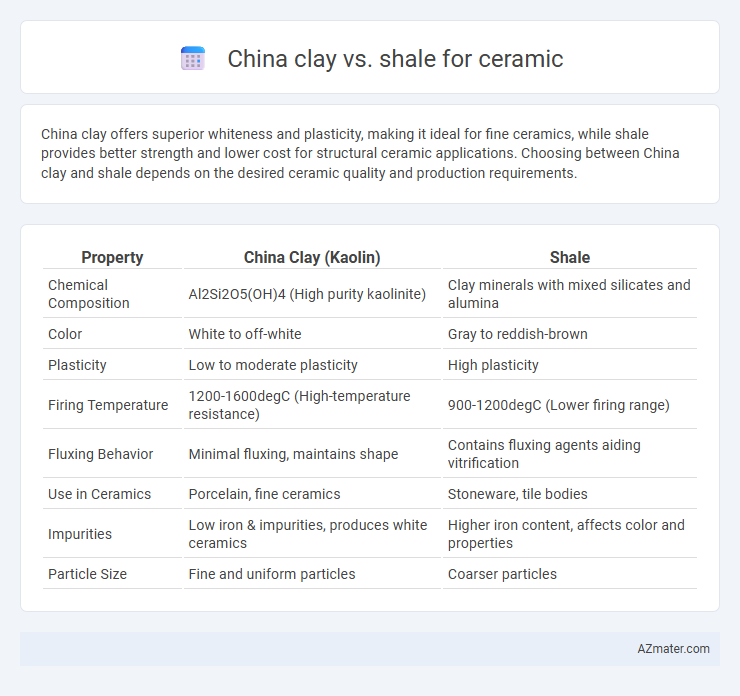China clay offers superior whiteness and plasticity, making it ideal for fine ceramics, while shale provides better strength and lower cost for structural ceramic applications. Choosing between China clay and shale depends on the desired ceramic quality and production requirements.
Table of Comparison
| Property | China Clay (Kaolin) | Shale |
|---|---|---|
| Chemical Composition | Al2Si2O5(OH)4 (High purity kaolinite) | Clay minerals with mixed silicates and alumina |
| Color | White to off-white | Gray to reddish-brown |
| Plasticity | Low to moderate plasticity | High plasticity |
| Firing Temperature | 1200-1600degC (High-temperature resistance) | 900-1200degC (Lower firing range) |
| Fluxing Behavior | Minimal fluxing, maintains shape | Contains fluxing agents aiding vitrification |
| Use in Ceramics | Porcelain, fine ceramics | Stoneware, tile bodies |
| Impurities | Low iron & impurities, produces white ceramics | Higher iron content, affects color and properties |
| Particle Size | Fine and uniform particles | Coarser particles |
Introduction to Ceramic Raw Materials
China clay and shale are essential raw materials in ceramic production, each contributing distinct properties to the final product. China clay, also known as kaolin, is valued for its purity, whiteness, and plasticity, making it ideal for fine ceramics and porcelain. Shale, a sedimentary rock rich in alumina and silica, enhances strength and durability, serving as a flux to lower firing temperatures in ceramic bodies.
Understanding China Clay: Properties and Sources
China clay, also known as kaolin, is a soft, white clay primarily composed of the mineral kaolinite, valued in ceramics for its purity, plasticity, and high firing temperature tolerance. Found predominantly in regions like the UK, China, and the United States, its fine particle size and whiteness contribute to producing smooth, durable ceramic products with minimal impurities. In contrast, shale contains more impurities and requires higher processing, making china clay a preferred raw material for high-quality ceramic manufacturing.
Shale: Characteristics and Availability
Shale, a sedimentary rock comprising clay minerals and fine silt, is valued in ceramics for its plasticity, firing stability, and consistent particle size distribution, which contribute to excellent workability and reduced shrinkage in finished products. Its abundant global availability, particularly in regions like China, the United States, and Europe, makes it a cost-effective alternative to premium materials like China clay. The high iron content in shale can influence the color and strength of ceramic bodies, requiring careful formulation to optimize performance in applications such as tiles, sanitary ware, and porcelain.
Mineral Composition: China Clay vs Shale
China clay, primarily composed of kaolinite (Al2Si2O5(OH)4), offers high purity with minimal impurities like iron and quartz, making it ideal for producing white ceramics. Shale contains a blend of clay minerals including illite, chlorite, and varying amounts of quartz and feldspar, resulting in a more complex mineral matrix that influences the color and durability of ceramic products. The higher kaolinite content in China clay enhances plasticity and whiteness, while shale's mixed mineralogy can improve thermal stability but may require careful processing to control coloration.
Processing and Preparation Methods
China clay, or kaolin, undergoes wet processing involving ball milling, sedimentation, and centrifugation to remove impurities and achieve fine particle size, resulting in high purity and whiteness essential for ceramic applications. Shale requires crushing, grinding, and calcination to enhance its plasticity and remove organic content, followed by blending with other raw materials to optimize firing behavior. The differing mineralogical composition dictates these distinct preparation methods, affecting the final ceramic properties such as strength, color, and vitrification.
Performance in Ceramic Production
China clay, or kaolin, offers superior whiteness and plasticity essential for high-quality ceramic production, enhancing tile durability and surface smoothness. Shale contributes to ceramic strength and color variation but has lower plasticity, requiring careful blending with clays for optimal workability. In performance terms, china clay improves fired whiteness and reduces defects, while shale enhances mechanical strength and thermal shock resistance in ceramic products.
Impact on Ceramic Quality and Texture
China clay, known for its high purity and fine particle size, enhances ceramic quality by providing smooth texture and excellent plasticity, resulting in a refined, white, and translucent finish. In contrast, shale contains higher impurities and coarser particles, which can reduce ceramic strength and create a rougher texture, potentially leading to uneven firing and surface defects. The choice between China clay and shale significantly impacts the mechanical properties and aesthetic appeal of ceramics, with China clay favored for premium-quality products.
Cost and Economic Factors
China clay offers superior plasticity and whiteness, enhancing ceramic quality but comes with higher extraction and processing costs compared to shale. Shale is more abundant and cheaper, lowering raw material expenses but may require additional refining to meet ceramic standards, potentially increasing overall production costs. The choice impacts economic factors significantly, with china clay favored for premium ceramics and shale used in cost-sensitive mass production.
Environmental Considerations
China clay, known for its purity and fine particle size, typically requires less processing and generates lower dust emissions compared to shale, reducing its environmental footprint in ceramic production. Shale extraction often involves higher energy consumption and greater land disturbance due to its layered structure and hardness, leading to increased habitat disruption and carbon emissions. Recycling waste materials from both clays and implementing sustainable mining practices are crucial for minimizing environmental impact in the ceramic industry.
Choosing the Right Material for Ceramic Applications
China clay, also known as kaolin, offers high purity and whiteness, making it ideal for producing fine, white ceramics with superior plasticity and smooth texture. Shale, composed of fine-grained sedimentary rock, provides strength and durability but often requires processing to reduce impurities that can affect ceramic quality. Choosing the right material depends on the desired ceramic properties: china clay for delicate, high-quality porcelain and shale for more robust, structural ceramics.

Infographic: China clay vs Shale for Ceramic
 azmater.com
azmater.com